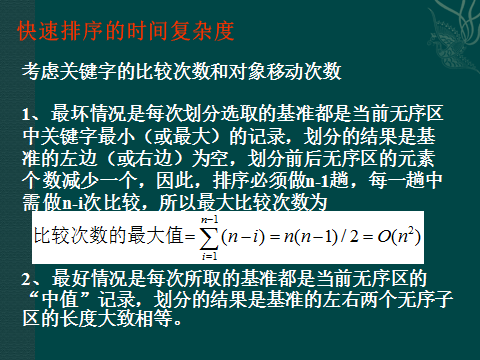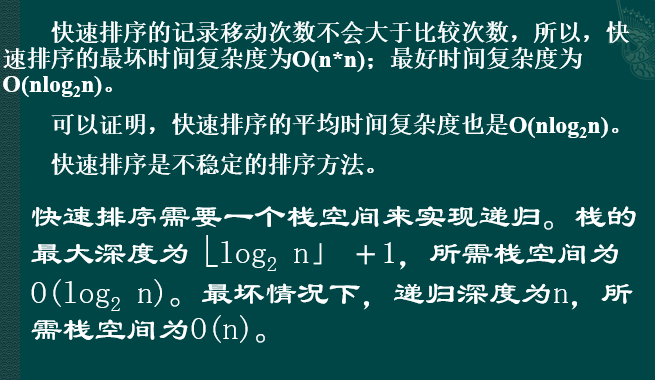快速排序是冒泡排序的优化,是一种非常高效的排序, 甚至是目前为止最高效的排序,其思想是这样的:设数组a中存放了n个数据元素,low为数组的低端下标,high为数组的高端下标,从数组a中任取一个元素(通常取a[low])做为标准元素,以该标准元素调整数组a中其他各个元素的位置,使排在标准元素前面的元素均小于标准元素,排在标准元素后面的均大于或等于标准元素,由此将数组根据标准元素分解成了两个子数组。对这两个子数组中的元素分别再进行方法类同的递归快速排序。算法的递归出口条件是low≥high。
可能讲到这里你不太懂, 但是看完步骤之后你一定会懂得。
步骤如下:
1、有一个数据a [ n ],
2、定义一个低端下标 low 和 一个高端下标 high;
3、定义i, j 两个变量;
4、设置条件:如果 low >= high 算法结束,否则进行以下步骤;
5、取数组第一个数作为标准 int standar, j = high, i = low
6、当 i < j 时, 从数组最后向前寻找,如果条件满足 i < j(因为可能在找的过程中i 和 j 的值发生了改变) , 并且a[ j ] >= standar, j--
不满足时停止 ,令 a[ i ] = a[ j ], 然后 i 的下标右移 i++;
7、当 i < j 时, 从数组开始向后寻找,如果条件满足 i < j(因为可能在找的过程中i 和 j 的值发生了改变) , 并且a[ i ] <= standar, i++
不满足时停止 ,令 a[ j ] = a[ i ], 然后 i 的下标左移 j--;
8、退出整个循环体、令 i 位置的值为standar
9、递归数组的两个子数组
对应代码为:
package quickSort; public class QuickSort { public int[] quicksort(int a[], int low, int high) { int i, j; if (low >= high) { return a; } else { int standar = a[low]; i = low; j = high; while (i < j) { while (i < j && a[j] >= standar) { j--; } if(i < j){ a[i] = a[j]; i++; } while (i < j && a[i] < standar) { i++; } if(i < j){ a[j] = a[i]; j--; } } a[i] = standar; quicksort(a, low, i - 1); quicksort(a, i + 1, high); return a; } } public int[] sort(int a[], int low, int high) { a = quicksort(a, low, high); return a; } }
测试类为:
package Test; import org.omg.CORBA.Current; import bubbleSort.BubbleSort; import insertSort.InsertSort; import quickSort.QuickSort; import selectSort.SelectSort; public class Test { public static void main(String[] args) { QuickSort quickSort = new QuickSort(); int[] array = createArray(); long ct1 = System.currentTimeMillis(); int[] arrays = quickSort.sort(array, 0, array.length - 1); long ct2 = System.currentTimeMillis(); display(arrays); System.out.println("所消耗的时间:" + (ct2 - ct1)); } public static void display(int[] arrays) { System.out.println("排序后数据:"); for (int i = 0; i < arrays.length; i++) { System.out.print(arrays[i] + " "); if ((i + 1) % 10 == 0) { System.out.println(); } } System.out.println(); } public static int[] createArray() { int[] array = new int[100000]; System.out.println("数组中元素是:"); for (int i = 0; i < 100000; i++) { array[i] = (int) (Math.random() * 1000); System.out.print(array[i] + " "); if ((i + 1) % 10 == 0) { System.out.println(); } } System.out.println(); return array; } }
时间复杂度:



经过计算:10000个数的排序时间为2 ms, 100000个数的排序时间为 40ms , 比上次测试的 冒泡排序14000ms 快了 300多倍。